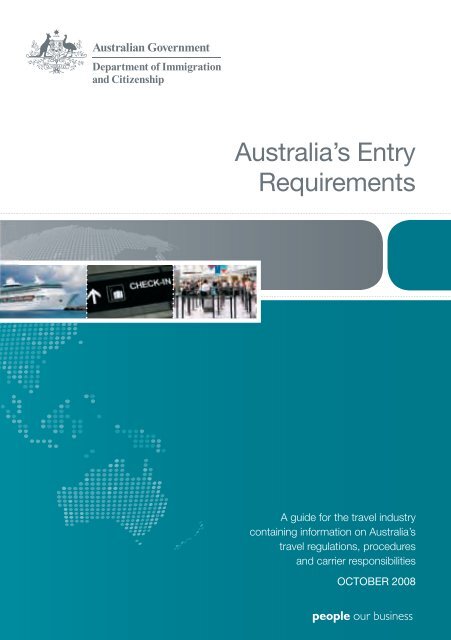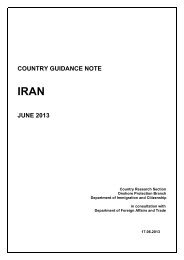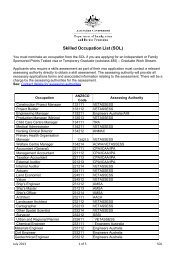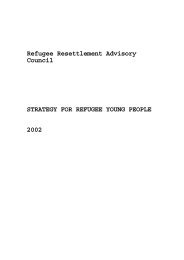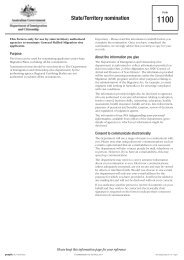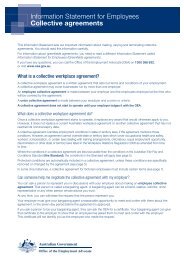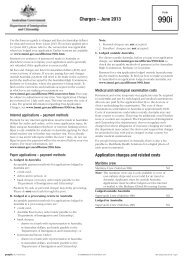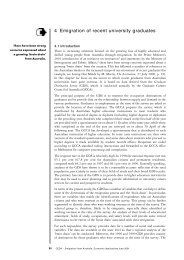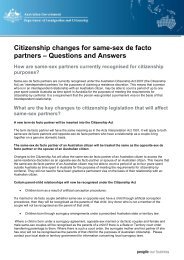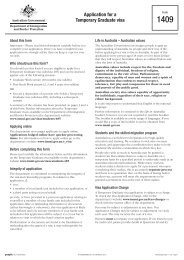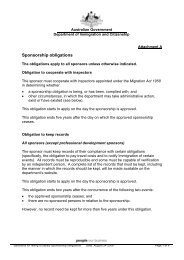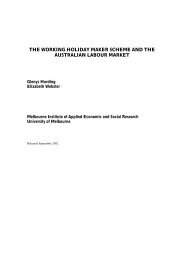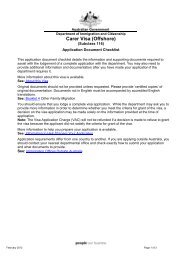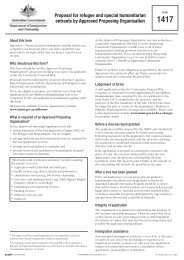Australia's entry requirements - Department of Immigration ...
Australia's entry requirements - Department of Immigration ...
Australia's entry requirements - Department of Immigration ...
Create successful ePaper yourself
Turn your PDF publications into a flip-book with our unique Google optimized e-Paper software.
Australia’s Entry<br />
Requirements<br />
A guide for the travel industry<br />
containing information on Australia’s<br />
travel regulations, procedures<br />
and carrier responsibilities<br />
OCTOBER 2008
Australia’s Entry<br />
Requirements
Disclaimer<br />
Please note this information is correct at time <strong>of</strong> printing.<br />
For up to date information see www.immi.gov.au<br />
Feedback/suggestions regarding this manual can be sent to<br />
Email: airports.policy@immi.gov.au<br />
© Commonwealth <strong>of</strong> Australia 2008<br />
This work is copyright. You may download, display, print and reproduce<br />
this material in unaltered form only (retaining this notice) for your personal,<br />
non-commercial use or use within your organisation. Apart from any use<br />
as permitted under the Copyright Act 1968, all other rights are reserved.<br />
Requests for further authorisation should be directed to the:<br />
Commonwealth Copyright Administration,<br />
Copyright Law Branch,<br />
Attorney-General’s <strong>Department</strong><br />
Robert Garran Officers<br />
National Circuit<br />
Barton ACT 2600<br />
Fax: 02 6250 5989<br />
Email:commonwealth.copyright@ag.gov.au.<br />
Published by the National Communications Branch <strong>of</strong> the<br />
<strong>Department</strong> <strong>of</strong> <strong>Immigration</strong> and Citizenship<br />
6 Chan Street Belconnen ACT 2615<br />
ISBN 978-0-983727-5-5
Contents<br />
Introduction 1<br />
1. Who is this guide for? 2<br />
2. Carrier responsibilities 3<br />
3. Travel documents 5<br />
3.1 Australian passports 5<br />
3.2 New Zealand passport holders 9<br />
3.3 Other passport holders 9<br />
3.4 Other acceptable travel documents 10<br />
4. Fraudulent documents 15<br />
5. Visa <strong>requirements</strong> 16<br />
5.1 Electronic travel authorities/electronic visas 16<br />
5.2 Visa Labels 16<br />
5.3 Return endorsements and authority to return 18<br />
5.4 Crew travel authority 19<br />
6. Visa exceptions 20<br />
6.1 Transit visa arrangements 20<br />
Attachments<br />
A – ICAO codes 21<br />
B – Passengers who do not need to<br />
obtain a visa before travelling to Australia 27<br />
C – Tips for detecting fraudulent documents 30<br />
D – ETA eligible passports 33<br />
E – Acronyms 34
Introduction<br />
Australia welcomes people travelling to Australia for business,<br />
pleasure, study and those returning home after periods <strong>of</strong> absence.<br />
The Australian Government seeks to ensure that only correctly<br />
documented passengers and crew travel to Australia. The obligations<br />
on international air carriers entering Australia are defined in the<br />
Migration Act 1958 and Migration Regulations 1994.<br />
Most passengers and crew have correct travel documents and<br />
check-in arrangements usually proceed smoothly. However, a small<br />
minority <strong>of</strong> passengers or crew will attempt to defraud carrier<br />
personnel and Australian immigration authorities by boarding<br />
Australian bound aircraft using false or fraudulent travel documents<br />
and visas.<br />
By providing this guide and working closely with carriers the<br />
<strong>Department</strong> <strong>of</strong> <strong>Immigration</strong> and Citizenship (DIAC) hopes to improve<br />
relationships with carriers and help carriers better understand<br />
Australia’s Advance Passenger Processing (APP) <strong>entry</strong> <strong>requirements</strong><br />
and processes.<br />
AER – Australia’s Entry Requirements | Introduction<br />
1
AER – Australia’s Entry Requirements | Who is this guide for?<br />
2<br />
1 Who is this guide for?<br />
This guide is intended for carrier personnel and in particular, check-in<br />
agents. It provides:<br />
• an outline <strong>of</strong> Australian immigration <strong>entry</strong> <strong>requirements</strong><br />
• information on passports, visas and other travel documents<br />
• details <strong>of</strong> how to process a passenger or crew member travelling<br />
to or transiting Australia<br />
• information on carrier responsibilities and<br />
• details <strong>of</strong> how to get assistance.<br />
This document is issued as a guide only. It is not meant to deal with<br />
every situation. It will however provide advice on the most common<br />
situations that check-in agents may have to deal with.<br />
More information is available in the Travel Information Manual (TIM),<br />
TIMATIC, and at www.timaticweb.com.
2 Carrier responsibilities<br />
The <strong>Department</strong> <strong>of</strong> <strong>Immigration</strong> and Citizenship (DIAC) seeks to work<br />
closely with carriers to ensure that only correctly documented<br />
passengers or crew board planes for travel to Australia. Prior to<br />
boarding passengers or crew, carriers are expected to:<br />
• ensure that the passport or travel document presented by the<br />
passenger or crew member is acceptable for <strong>entry</strong> into Australia,<br />
that the passport is valid, and that the passenger or crew<br />
member is the rightful holder<br />
• confirm if the passenger or crew member needs a visa, and if they<br />
do, that the visa is valid and<br />
• provide advance passenger information for every passenger and<br />
crew on board the aircraft to Australian immigration authorities via<br />
the APP system.<br />
Carriers which bring inadmissible passengers or crew (eg. no<br />
passport, expired visa, no visa held, or false documentation) to<br />
Australia may face prosecution under the Migration Act 1958 or have<br />
financial penalties imposed on them unless they can demonstrate<br />
that all reasonable steps were undertaken at check-in to ensure that<br />
all passengers or crew had acceptable travel documents.<br />
The responsibility for deciding whether to carry a passenger or crew<br />
member lies with the carrier in every case.<br />
AER – Australia’s Entry Requirements | Carrier responsibilities<br />
3
AER – Australia’s Entry Requirements | Carrier responsibilities<br />
4<br />
DIAC runs an Entry Operations Centre (EOC) which provides a<br />
helpdesk facility to carriers. The EOC operates 24 hours a day, seven<br />
days a week. Airports with or without an Airline Liaison Officer (ALO)<br />
may contact the EOC at any time to inquire about the immigration<br />
status <strong>of</strong> passengers or crew who are intending to travel to Australia.<br />
The contact details for the EOC are:<br />
Entry Operations Centre:<br />
Canberra Australia (24 hour, seven days operation)<br />
Phone: +61 1300 368 126 – Airline and other enquiries<br />
+61 1300 368 970 – Seaport enquiries<br />
Fax: +61 1300 368 422<br />
Sitatex: CBRIXCR<br />
Email: eoc@immi.gov.au
3 Travel documents<br />
Anyone travelling to Australia must have in their possession<br />
documentation <strong>of</strong> their identity and nationality. The most common<br />
and preferred travel document for international travel is a passport.<br />
Other types <strong>of</strong> travel documents are also acceptable. For information<br />
about other types <strong>of</strong> documents see Section 3.4.<br />
3.1 Australian passports<br />
Australia issues Standard (blue), Official (green) and Diplomatic (red)<br />
passports. Standard Australian passports are 32 pages. Frequent<br />
traveller passports will have 64 pages. Most Australian adult<br />
passports are valid for 10 years. In some circumstances, the validity<br />
may be less than 10 years. Seniors’ (75 years and over) and<br />
children’s passports are valid for five years.<br />
Holders <strong>of</strong> Australian passports have a right to enter Australia and<br />
do not require a visa.<br />
Examples <strong>of</strong> Standard, Official and Diplomatic Passports are<br />
displayed on the following pages.<br />
AER – Australia’s Entry Requirements | Travel documents<br />
5
AER – Australia’s Entry Requirements | Travel documents<br />
6<br />
Australian Standard Passport<br />
Cover:<br />
Biographical details:
Australian Official Passport<br />
Cover:<br />
Biographical details:<br />
AER – Australia’s Entry Requirements | Travel documents<br />
7
AER – Australia’s Entry Requirements | Travel documents<br />
8<br />
Australian Diplomatic Passport<br />
Cover:<br />
Biographical details:
3.2 New Zealand passport holders<br />
Holders <strong>of</strong> valid New Zealand passports do not require a visa to<br />
board a plane for travel to Australia. New Zealand issues Standard<br />
(blue), Official (green) and Diplomatic (red) passports.<br />
Most New Zealand citizens will be granted an electronic Special<br />
Category Visa (SCV) on arrival in Australia, subject to meeting health<br />
and character <strong>requirements</strong>.<br />
3.3 Other passport holders<br />
All other travellers must be holders <strong>of</strong> a passport or another<br />
acceptable travel document. Refer to Section 3.4 for other<br />
acceptable documents. Passports must be valid and most<br />
passengers travelling on a foreign passport will require an Electronic<br />
Travel Authority (ETA) or a visa. For information on Australia’s ETA and<br />
visa <strong>requirements</strong> see Section 5.<br />
AER – Australia’s Entry Requirements | Travel documents<br />
9
AER – Australia’s Entry Requirements | Travel documents<br />
10<br />
3.4 Other acceptable travel documents<br />
At check-in, a small number <strong>of</strong> passengers or crew will present other<br />
types <strong>of</strong> travel documents which are also acceptable for travel to<br />
Australia. Some recognised authorities and many countries, including<br />
Australia, issue a variety <strong>of</strong> other acceptable travel documents.<br />
Holders <strong>of</strong> these documents will in most cases also require a visa.<br />
Other acceptable documents include:<br />
• Document for Travel to Australia (DFTTA) (visa required)<br />
• Document <strong>of</strong> Identity (if holder is not an Australian citizen then<br />
visa required)<br />
• Certificate <strong>of</strong> Identity (visa required)<br />
• Convention Travel Document (such as Titre de Voyage –<br />
visa required)<br />
• Laissez Passer (visa required)<br />
• Military Identity Documents (issued to members <strong>of</strong> the armed<br />
forces <strong>of</strong> the following countries, provided travelling on duty and<br />
holding a Movement Order): Antigua and Barbuda, Bahamas,<br />
Barbados, Belize, Brunei Darussalam, Canada, Fiji, Grenada,<br />
Jamaica, Malaysia, Mauritius, New Zealand, Papua New Guinea,<br />
Singapore, Solomon Islands, St. Kitts & Nevis, St. Lucia, St.<br />
Vincent and the Grenadines, Thailand, Tonga, Tuvalu, United<br />
Kingdom and the USA).<br />
For further details carriers should refer to TIM.<br />
Examples <strong>of</strong> a DFTTA, Document <strong>of</strong> Identity, Certificate <strong>of</strong> Identity and<br />
Titre De Voyage and are displayed on the following pages.
Document for Travel to Australia<br />
DFTTA<br />
Note: Example not to actual size. The DFTTA is A4 in size<br />
AER – Australia’s Entry Requirements | Travel documents<br />
11
AER – Australia’s Entry Requirements | Travel documents<br />
12<br />
Australian Document <strong>of</strong> Identity<br />
Cover:<br />
Biographical details:
Certificate <strong>of</strong> Identity<br />
Cover:<br />
Biographical details:<br />
AER – Australia’s Entry Requirements | Travel documents<br />
13
AER – Australia’s Entry Requirements | Travel documents<br />
14<br />
Titre De Voyage<br />
Cover:<br />
Biographical details:
4 Fraudulent documents<br />
Fraudulent documents include those obtained because <strong>of</strong> false or<br />
misleading statements. They may also be counterfeit or fraudulently<br />
altered. They may not always be easily identified or detected but<br />
check-in agents should be aware that some passengers will attempt<br />
to board an aircraft using these documents.<br />
The biographical page <strong>of</strong> a travel document is the section most likely<br />
to have been altered. Check-in agents should pay particular attention<br />
to the photograph in the document. It should match the passenger or<br />
crew who is presenting for check-in.<br />
Suspect documents should be referred to a supervisor or the<br />
Australian Airline Liaison Officer (ALO), if there is one in the airport or<br />
region. Fraudulent travel documents are not valid for travel to<br />
Australia. See Attachment C for tips on detecting fraudulent<br />
travel documents.<br />
AER – Australia’s Entry Requirements | Fraudulent documents<br />
15
AER – Australia’s Entry Requirements | Visa <strong>requirements</strong><br />
16<br />
5 Visa <strong>requirements</strong><br />
With few exceptions all passengers and crew travelling to Australia<br />
must hold a valid visa, an Electronic Travel Authority (ETA) or a Crew<br />
Travel Authority (CTA). Australian and New Zealand passport holders<br />
and passengers listed in Attachment B are not required to obtain a<br />
visa or an ETA.<br />
Additional information about Australian visas can be found at<br />
www.immi.gov.au.<br />
5.1 Electronic Travel Authorities/<br />
electronic visas<br />
DIAC issues a range <strong>of</strong> electronic visas (eVisa) and ETAs.<br />
Carriers should be aware that there will not be any physical evidence<br />
<strong>of</strong> an eVisa or ETA in a passenger’s or crew member’s<br />
travel document.<br />
Check-in agents are able to determine whether an ETA or an eVisa is<br />
held by completing an APP transaction through the APP System or a<br />
TIETAQ check through the ETA System.<br />
A list <strong>of</strong> ETA eligible passports is at Attachment D<br />
5.2 Visa labels<br />
Visa labels are the traditional hardcopy visas which are affixed into the<br />
travel documents <strong>of</strong> passengers (see example <strong>of</strong> visa label on next<br />
page). Today, only a small number <strong>of</strong> passengers are travelling with<br />
printed visa labels.<br />
Passengers may present at check-in with two passports – a valid<br />
passport and an expired passport holding an Australian visa that is<br />
still valid for travel.
Provided the visa is still valid (check the expiry date <strong>of</strong> the visa or refer<br />
to the EOC if unsure) and the passenger has a new passport they are<br />
considered to be adequately documented for travel to Australia.<br />
Below are examples <strong>of</strong> two <strong>of</strong> the most common visa labels that may<br />
be presented at check-in. Not all visa types are shown in<br />
this booklet.<br />
Red and blue/green visa labels<br />
AER – Australia’s Entry Requirements | Visa <strong>requirements</strong><br />
17
AER – Australia’s Entry Requirements | Visa <strong>requirements</strong><br />
18<br />
5.3 Return Endorsements and Authority to Return<br />
These visas were only issued to permanent residents <strong>of</strong> Australia and<br />
are in the form <strong>of</strong> a stamp. These types <strong>of</strong> visas were issued prior to<br />
the visa label regime. This older style <strong>of</strong> visa will only be seen in very<br />
limited circumstances. They are valid for travel to Australia provided<br />
the holder has not been absent from Australia for more than three<br />
years. Check-in agents should look for the last departure stamp from<br />
Australia (see example on page 19) in a passenger’s passport to<br />
verify absence has not been longer than three years. These visas will<br />
be in expired passports. Examples <strong>of</strong> Return Endorsements and<br />
Authority to Return stamps are shown below and on next page.<br />
Return Endorsements
Authority to return to Australia<br />
Departed Australia stamp<br />
5.4 Air Crew Travel Authority (CTA)<br />
All crew are required to hold a valid passport and airline identification<br />
and must be registered with a Crew Travel Authority (CTA). A CTA is<br />
valid for the life <strong>of</strong> the passport. There is no evidence <strong>of</strong> the CTA<br />
registration in a passport.<br />
A CTA registration can be completed easily online via the APP<br />
website www.eta.immi.gov.au/app.html. Carriers will have registered<br />
users who can access the APP website. If carriers require additional<br />
staff to be registered to access the APP website they should send an<br />
email to the APP Mailbox appwebsite@immi.gov.au.<br />
The APP website also provides a facility for carriers to check if crew hold a<br />
CTA. It can also provide information on the validity <strong>of</strong> a CTA.<br />
Registration <strong>of</strong> crew is usually completed by the carrier personnel or<br />
crewing areas.<br />
AER – Australia’s Entry Requirements | Visa <strong>requirements</strong><br />
19
AER – Australia’s Entry Requirements | Visa exceptions<br />
20<br />
6 Visa exceptions<br />
Although most passengers travelling to or through Australia require a<br />
visa there are some exceptions. These include certain Military and UN<br />
personnel, certain transit passengers, Permanent Residents <strong>of</strong><br />
Norfolk Island and New Zealand passport holders. A comprehensive<br />
list is at Attachment B. This information is also available in TIM.<br />
6.1 Transit visa arrangements<br />
Nationals not listed in the transit passenger section at Attachment B<br />
require a visa to transit through Australia even if they simply pass<br />
through an airport on connecting flights and so do not pass through<br />
immigration clearance.<br />
The only transit visa is the Transit Visa Subclass 771. These visa<br />
holders must show pro<strong>of</strong> <strong>of</strong> a return or onward ticket for a destination<br />
other than Australia. Once a Subclass 771 transit visa is granted,<br />
travellers are able to stay in Australia for a maximum <strong>of</strong> 72 hours, and<br />
are able to board domestic flights (as they have gone through<br />
immigration clearance).
Attachment A<br />
ICAO codes for countries and regions<br />
Country<br />
ICAO<br />
Code<br />
Afghanistan AFG<br />
Albania ALB<br />
Algeria DZA<br />
American Samoa ASM<br />
Andorra AND<br />
Angola AGO<br />
Anguilla AIA<br />
Antarctica ATA<br />
Antigua and Barbuda ATG<br />
Argentina ARG<br />
Armenia ARM<br />
Aruba ABW<br />
Australia AUS<br />
Austria AUT<br />
Azerbaijan AZE<br />
Bahamas BHS<br />
Bahrain BHR<br />
Bangladesh BGD<br />
Barbados BRD<br />
Belarus BLR<br />
Belgium BEL<br />
Belize BLZ<br />
Country<br />
ICAO<br />
Code<br />
Benin BEN<br />
Bermuda BMU<br />
Bhutan BTN<br />
Bolivia BOL<br />
Bosnia and<br />
Herzegovina<br />
BIH<br />
Botswana BWA<br />
Bouvet Island BVT<br />
Brazil BRA<br />
British – Citizen GBR<br />
British – Dependant<br />
Territories Citizen<br />
GBD<br />
British – National<br />
Overseas<br />
GBN<br />
British – Overseas<br />
Citizen<br />
GBO<br />
British – Protected<br />
Person<br />
GBP<br />
British – Subject GBS<br />
Brunei Darussalam BRN<br />
Bulgaria BGR<br />
Burkina Faso BFA<br />
Burundi BDI<br />
AER – Australia’s Entry Requirements | Attachments<br />
21
AER – Australia’s Entry Requirements | Attachment A<br />
22<br />
Country<br />
ICAO<br />
Code<br />
Cambodia KHM<br />
Cameroon CMR<br />
Canada CAN<br />
Cape Verde CPV<br />
Cayman Islands CYM<br />
Chad TCD<br />
Central African<br />
Republic<br />
CAF<br />
Chile CHL<br />
China CHN<br />
Christmas Island CXR<br />
Cocos (Keeling) Isl CCK<br />
Colombia COL<br />
Comoros COM<br />
Congo COG<br />
Dem Rep <strong>of</strong> the<br />
Congo<br />
COD<br />
Cook Islands COK<br />
Costa Rica CRI<br />
Cote D’ivoire CIV<br />
Croatia HRV<br />
Cuba CUB<br />
Cyprus CYP<br />
Czech Republic CZE<br />
Czechoslovakia CSK<br />
Denmark DNK<br />
Country<br />
ICAO<br />
Code<br />
Djibouti DJI<br />
Dominica DMA<br />
Dominican Republic DOM<br />
East Timor TMP<br />
Ecuador ECU<br />
Egypt EGY<br />
El Salvador SLV<br />
Equatorial Guinea GNQ<br />
Eritrea ERI<br />
Estonia EST<br />
Ethiopia ETH<br />
Falkland Islands FLK<br />
Faroe Islands FRO<br />
Fiji FJI<br />
Finland FIN<br />
France FRA<br />
France – Metropolitan FXX<br />
French Guiana GUF<br />
French Polynesia PYF<br />
French Southern<br />
Territories<br />
ATF<br />
Gabon GAB<br />
Gambia GMB<br />
Georgia GEO
Country<br />
South Georgia and<br />
the South Sandwich<br />
Islands<br />
ICAO<br />
Code<br />
SGS<br />
Germany D<br />
Ghana GHA<br />
Gibraltar GIB<br />
Great Britain – Citizen GBR<br />
Great Britain – National<br />
Overseas<br />
GBN<br />
Greece GRC<br />
Greenland GRL<br />
Grenada GRD<br />
Guadeloupe GLP<br />
Guam GUM<br />
Guatemala GTM<br />
Guinea GIN<br />
Guinea-Bissau GNB<br />
Guyana GUY<br />
Haiti HTI<br />
Heard and Mcdonald<br />
Islands<br />
HMD<br />
Honduras HND<br />
Hong Kong (SAR) HKG<br />
Hungary HUN<br />
Iceland ISL<br />
India IND<br />
Country<br />
ICAO<br />
Code<br />
Indonesia IDN<br />
British Indian Ocean<br />
Territory<br />
IOT<br />
Iran IRN<br />
Iraq IRQ<br />
Ireland IRL<br />
Israel ISR<br />
Italy ITA<br />
Jamaica JAM<br />
Japan JPN<br />
Jordan JOR<br />
Kazakhstan KAZ<br />
Kenya KEN<br />
Kiribati KIR<br />
Korea, Republic <strong>of</strong><br />
(Sth)<br />
KOR<br />
Korea, Dem Peoples<br />
(Nth)<br />
PRK<br />
Kuwait KWT<br />
Kyrgyzstan KGZ<br />
Lao Peoples Dem Rep LAO<br />
Latvia LVA<br />
Lebanon LBN<br />
Lesotho LSO<br />
Liberia LBR<br />
Libyan Arab Jamahiri LBY<br />
AER – Australia’s Entry Requirements | Attachment A<br />
23
AER – Australia’s Entry Requirements | Attachment A<br />
24<br />
Country<br />
ICAO<br />
Code<br />
Liechtenstein LIE<br />
Lithuania LTU<br />
Luxembourg LUX<br />
Macau MAC<br />
FYROM – Former<br />
Yugoslav Republic<br />
<strong>of</strong> Macedonia<br />
MKD<br />
Madagascar MDG<br />
Malawi MWI<br />
Malaysia MYS<br />
Maldives MDV<br />
Mali MLI<br />
Malta MLT<br />
Marshall Islands MHL<br />
Martinique MTQ<br />
Mauritania MRT<br />
Mauritius MUS<br />
Mayotte MYT<br />
Mexico MEX<br />
Micronesia –<br />
Federated States <strong>of</strong><br />
FSM<br />
Moldova, Republic <strong>of</strong> MDA<br />
Monaco MCO<br />
Mongolia MNG<br />
Montenegro MNE<br />
Montserrat MSR<br />
Country<br />
ICAO<br />
Code<br />
Morocco MAR<br />
Mozambique MOZ<br />
Myanmar MMR<br />
Namibia NAM<br />
Nauru NRU<br />
Nepal NPL<br />
Netherlands<br />
– Kingdom<br />
NLD<br />
Netherlands Antilles ANT<br />
New Caledonia NCL<br />
New Zealand NZL<br />
Nicaragua NIC<br />
Niger NER<br />
Nigeria NGA<br />
Niue NIU<br />
Norfolk Island NFK<br />
Northern Mariana Isl MNP<br />
Norway NOR<br />
Oman OMN<br />
Pakistan PAK<br />
Palau PLW<br />
Palestinian Authority PSE<br />
Panama PAN<br />
Papua New Guinea PNG<br />
Paraguay PRY<br />
Peru PER
Country<br />
ICAO<br />
Code<br />
Philippines PHL<br />
Pitcairn PCN<br />
Poland POL<br />
Portugal PRT<br />
Puerto Rico PRI<br />
Qatar QAT<br />
Refugee as per Article<br />
1, 1951 Convention<br />
XXB<br />
Refugee other than<br />
Article 1 <strong>of</strong> 1951<br />
Convention<br />
XXC<br />
Reunion REU<br />
Romania ROM<br />
Russian Federation RUS<br />
Rwanda RWA<br />
Sahara, Western ESH<br />
Saint Lucia LCA<br />
Samoa WSM<br />
San Marino,<br />
Republic <strong>of</strong><br />
SMR<br />
Sao Tome and Principe STP<br />
Saudi Arabia SAU<br />
Senegal SEN<br />
Serbia SRB<br />
Serbia & Montenegro SCG<br />
Seychelles SYC<br />
Sierra Leone SLE<br />
Country<br />
ICAO<br />
Code<br />
Singapore SGP<br />
Slovak Republic SVK<br />
Slovenia SVN<br />
Solomon Islands SLB<br />
Somalia SOM<br />
South Africa ZAF<br />
Spain ESP<br />
Sri Lanka LKA<br />
Stateless Person XXA<br />
St Helena SHN<br />
St Kitts & Nevis KNA<br />
St Pierre and Miquelon SPM<br />
St Vincent & the<br />
Grenadines<br />
VCT<br />
Sudan SDN<br />
Suriname SUR<br />
Svalbard and Jan<br />
Mayen Island<br />
SJM<br />
Sweden SWE<br />
Swaziland SWZ<br />
Switzerland CHE<br />
Syrian Arab Republic SYR<br />
Taiwan TWN<br />
Tajikistan TJK<br />
Tanzania TZA<br />
Thailand THA<br />
AER – Australia’s Entry Requirements | Attachment A<br />
25
AER – Australia’s Entry Requirements | Attachment A<br />
26<br />
Country<br />
ICAO<br />
Code<br />
Timor – East TMP<br />
Timor – Leste TLS<br />
Togo TGO<br />
Tokelau TKL<br />
Tonga TON<br />
Trinidad and Tobago TTO<br />
Tunisia TUN<br />
Turkey TUR<br />
Turkmenistan TKM<br />
Turks and Caicos<br />
Islands<br />
TCA<br />
Tuvalu TUV<br />
Uganda UGA<br />
Ukraine UKR<br />
United Arab Emirates ARE<br />
United Kingdom<br />
– Citizen<br />
GBR<br />
United Kingdom<br />
– National Overseas<br />
GBN<br />
Country<br />
ICAO<br />
Code<br />
United States USA<br />
Unspecified Nationality XXX<br />
Uruguay URY<br />
Uzbekistan UZB<br />
Vanuatu VUT<br />
Vatican City State VAT<br />
Venezuela VEN<br />
Vietnam VNM<br />
Virgin Islands (Brit) VGB<br />
Virgin Islands (US) VIR<br />
Wallis and Futuna<br />
Islands<br />
WLF<br />
Yemen, Republic <strong>of</strong> YEM<br />
Yemen YMD<br />
Yugoslavia YUG<br />
Zaire ZAR<br />
Zambia ZME<br />
Zimbabwe ZWE
Attachment B<br />
Passengers who do not need to obtain a visa<br />
before travelling to Australia<br />
(from TIMATIC or TIM)<br />
All persons entering Australia must hold a visa except for:<br />
1. nationals <strong>of</strong> Australia<br />
2. members <strong>of</strong> the Armed Forces, provided they are travelling on<br />
duty, hold Military Identification or a valid passport, and also hold<br />
Movement Orders from one <strong>of</strong> the following countries: Antigua &<br />
Barbuda, Bahamas, Barbados, Belize, Brunei Darussalam,<br />
Canada, Fiji, Grenada, Jamaica, Malaysia, Mauritius,<br />
New Zealand, Solomon Islands, St. Kitts & Nevis, St. Lucia,<br />
St. Vincent & the Grenadines, Thailand, Tonga, Tuvalu,<br />
United Kingdom<br />
3. Armed Forces <strong>of</strong> Malaysia, Papua New Guinea, Singapore<br />
and USA:<br />
a) military personnel holding Movement Orders and either Military<br />
B<br />
Identification or a valid passport<br />
b) civilian component <strong>of</strong> ‘a)’ above, provided they hold a valid<br />
passport and a Status Certificate stamped in their passport or<br />
Attachment |<br />
on <strong>of</strong>ficial letterhead<br />
4. accompanying or joining spouse or dependant relatives <strong>of</strong> ‘2’,<br />
‘3a)’ or ‘3b)’ if they hold a valid passport and either Movement<br />
Requirements<br />
Orders or a Status Certificate<br />
Entry<br />
5. permanent residents <strong>of</strong> Norfolk Island holding a passport<br />
endorsed with the authority to reside indefinitely in Norfolk Island.<br />
Australia’s<br />
These passengers must apply for a ‘Permanent Residents <strong>of</strong><br />
–<br />
Norfolk Island Visa’ on arrival at the Australian border AER<br />
27
AER – Australia’s Entry Requirements | Attachment B<br />
28<br />
6. nationals <strong>of</strong> New Zealand who must apply for a ‘Special Category<br />
Visa’ (SCV) by presenting a valid New Zealand passport and a<br />
completed passenger card on arrival at the Australian border<br />
7. personnel employed by the United Nations Mission in Timor<br />
Leste, holding a valid passport or travel document and a UN<br />
identity card or a letter from the UN identifying them as personnel<br />
employed by UN operations in Timor Leste<br />
Transit Passengers Without Visas (TWOV).<br />
8. passengers transiting to a third country by the same, or a<br />
connecting aircraft within eight hours <strong>of</strong> scheduled arrival time.<br />
These passengers must:<br />
• hold a ticket, or evidence <strong>of</strong> an e-ticket, with confirmed<br />
onward reservation<br />
• hold all documents required for their next destination and<br />
• not leave the transit lounge.<br />
They must also be in one <strong>of</strong> the following categories:<br />
a) a national <strong>of</strong> one <strong>of</strong> the following: Andorra, Argentina, Austria,<br />
Belgium, Brunei, Canada, Cyprus, Czech Republic, Denmark,<br />
Estonia, Fiji, Finland, France, Germany, Greece, Hungary, Iceland,<br />
Indonesia, Ireland, Italy, Japan, Kiribati, Korea Rep. (South),<br />
Latvia, Liechtenstein, Lithuania, Luxembourg, Malaysia, Malta,<br />
Marshall Islands, Mexico, Micronesia, Monaco, Nauru,<br />
Netherlands, New Zealand, Norway, Palau, Papua New Guinea,<br />
Philippines, Poland, Portugal, Samoa, San Marino, Singapore,<br />
Slovak Rep., Slovenia, Solomon Islands, South Africa, Spain,<br />
Sweden, Switzerland, Thailand, Tonga, Tuvalu, USA, Vanuatu,<br />
Vatican City or
) hold a Chinese Taipei normal passport only or<br />
c) hold a British passport (irrespective <strong>of</strong> endorsement in passport<br />
regarding national status) or<br />
d) be a national <strong>of</strong> China (People’s Republic) provided they hold a<br />
Hong Kong (SAR China) passport or<br />
e) hold a diplomatic passport. However, this is not applicable to<br />
nationals <strong>of</strong>:<br />
i. Afghanistan, Algeria, Angola, Bahrain, Bosnia and Herzegovina,<br />
Comoros Isl., Democratic People’s Republic <strong>of</strong> Korea (DPRK),<br />
Egypt, Iran, Iraq, Jordan, Kuwait, Lebanon, Libya, Madagascar,<br />
Mauritania, Morocco, Oman, Pakistan, Qatar, Russian Fed.,<br />
Saudi Arabia, Sierra Leone, Somalia, Sudan, Syria, Tunisia,<br />
United Arab-Emirates, Yemen Rep, Zimbabwe and Arab Non-<br />
National Passport Holders (ANNPH) and<br />
ii. Chinese Taipei holding diplomatic or <strong>of</strong>ficial passports.<br />
AER – Australia’s Entry Requirements | Attachment B<br />
29
AER – Australia’s Entry Requirements | Attachment C<br />
30<br />
Attachment C<br />
Tips for detecting fraudulent documents<br />
1. Examine the outside cover:<br />
• Check the cover material for cracking or wrinkling<br />
• Are there any creases or cuts to the spine?<br />
2. Examine the pages:<br />
• Check for any security features, for example intaglio printing,<br />
ultra violet<br />
• Check for tearing, staining, excess glue, or, other signs<br />
<strong>of</strong> tampering<br />
• Check printing quality for breaks in the lettering, or fine<br />
line blurring<br />
• Count the pages – are they numbered with the numbers in the<br />
same position and type style?<br />
• Are all <strong>of</strong> the pages the same size and colour?<br />
3. Examine the numbers:<br />
• Are the document numbers all <strong>of</strong> the same style? Are there signs<br />
<strong>of</strong> erasure, overwriting or substitution <strong>of</strong> a new number?<br />
• If perforated, are there any perforations which do not line up or<br />
are not <strong>of</strong> the same quality throughout?<br />
4. Biographical data:<br />
• Look for signs <strong>of</strong> erasure or overwriting, ie. fibre disturbance,<br />
staining or bleaching<br />
• Are all entries in the same handwriting, type style, and ink colour?
• Do the details match the bearer?<br />
• Check the expiry date (found on all passports) and extension<br />
date(s) if applicable for signs <strong>of</strong> alteration.<br />
5. Binding:<br />
• Binding should be consistent and tight<br />
• Binding on all pages should be clean and without extra holes.<br />
6. Photograph:<br />
• Check for any signs <strong>of</strong> a previous photograph<br />
• Check the reverse side <strong>of</strong> the photograph page (including the<br />
cover) for stains, wrinkling, abnormal thickness, or signs <strong>of</strong><br />
excess glue<br />
• If dry or wet seal impressions are present on the photograph, do<br />
they align with the remaining portions <strong>of</strong> the seals on the page?<br />
• Does the dry seal impression within the photograph align with<br />
the seal impression in the comparative area in the page behind<br />
the photograph?<br />
7. Lamina:<br />
• Is there a second layer <strong>of</strong> lamina?<br />
• Is there any wrinkling or lack <strong>of</strong> adhesion?<br />
• Does the lamina fit the page neatly or has it been trimmed to fit?<br />
• Are there any breaks in the security pattern?<br />
• Are there any cuts or tears along the edges <strong>of</strong> the photograph?<br />
AER – Australia’s Entry Requirements | Attachment C<br />
31
AER – Australia’s Entry Requirements | Attachment C<br />
32<br />
8. Ultra violet features:<br />
• Do all pages fluoresce at the same intensity?<br />
• Are the UV security features, threads, fibres or planchettes<br />
consistent on all pages?<br />
• Is there any disturbance or discoloration to the UV features<br />
in lamina?<br />
9. Production quality:<br />
• If watermarks are present are they in all pages? Do these<br />
watermarks fluoresce under UV light?<br />
• Do the security features, patterns or micro-printing show<br />
consistent quality?
Attachment D<br />
ETA eligible passports<br />
The following are ETA eligible passports that may be processed for an<br />
ETA. Details <strong>of</strong> all major countries and corresponding ICAO codes are<br />
listed in Attachment A <strong>of</strong> this manual.<br />
Andorra AND<br />
Austria AUT<br />
Belgium BEL<br />
Brunei Darussalam BRN<br />
Canada CAN<br />
Denmark DNK<br />
Finland FIN<br />
France FRA<br />
Germany D<br />
Greece GRC<br />
Hong Kong (SAR) HKG<br />
Iceland ISL<br />
Ireland IRL<br />
Italy ITA<br />
Japan JPN<br />
Korea, Republic <strong>of</strong><br />
(Sth)<br />
KOR<br />
Liechtenstein LIE<br />
Luxembourg LUX<br />
Malaysia MYS<br />
Malta MLT<br />
Monaco MCO<br />
Netherlands NLD<br />
Norway NOR<br />
Portugal PRT<br />
San Marino,<br />
Republic <strong>of</strong><br />
SMR<br />
Singapore SGP<br />
Spain ESP<br />
Sweden SWE<br />
Switzerland CHE<br />
*Taiwan TWN<br />
UK – Brit Citz GBR<br />
**UK – British<br />
National (Overseas)<br />
GBN<br />
United States USA<br />
Vatican VAT<br />
* Holders <strong>of</strong> Taiwan passports can only be processed for an ETA if resident in and applying in Taiwan.<br />
** Holders <strong>of</strong> UK passports which indicate their nationality to be British National (Overseas) can only be<br />
processed for an ETA if resident in and applying in Hong Kong.<br />
Access the latest list <strong>of</strong> countries on the internet at www.immi.gov.au.<br />
AER – Australia’s Entry Requirements | Attachment D<br />
33
AER – Australia’s Entry Requirements | Attachment E<br />
34<br />
Attachment E<br />
Acronyms<br />
API Advance Passenger Information<br />
APP Advance Passenger Processing System<br />
ALO Airline Liaison Officer<br />
CTA Crew Travel Authority<br />
DCS Departure Control System<br />
DIAC <strong>Department</strong> <strong>of</strong> <strong>Immigration</strong> and Citizenship<br />
DFTTA Document for Travel To Australia<br />
EOC Entry Operations Centre<br />
ETAS Electronic Travel Authority System<br />
ICAO International Civil Aviation Organisation<br />
MRZ Machine Readable Zone<br />
OAG Official Airline Guide<br />
TIETAQ The visa enquiry function on the ETA system<br />
TIM Travel Information Manual
Attachment F<br />
Contacts<br />
Entry Operations Centre:<br />
Canberra Australia<br />
(24 hour, seven days operation)<br />
Phone: Airline and other enquiries –<br />
+61 1300 368 126<br />
Seaport enquiries –<br />
+61 1300 368 970<br />
Fax: +61 1300 368 422<br />
Sitatex: CBRIXCR<br />
Email: eoc@immi.gov.au<br />
APP Support:<br />
Canberra Australia<br />
(during business hours)<br />
For queries in relation to<br />
APP processing:<br />
Email: appwebsite@immi.gov.au<br />
Phone: +61 2 6223 8291<br />
Fax: +61 2 6198 7436<br />
AER – Australia’s Entry Requirements | Attachment F<br />
35


